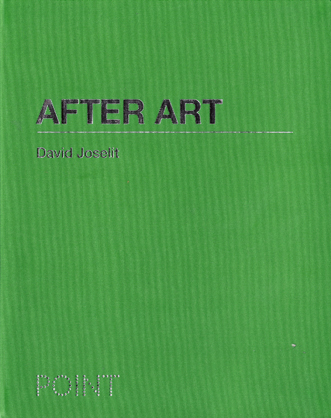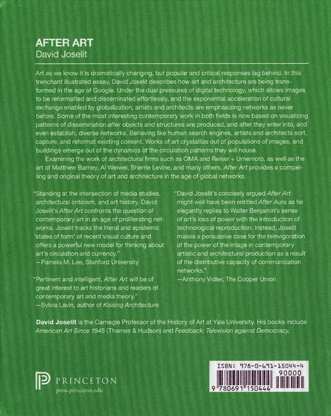David Joselit
28.10.2012
From: Joselit, David. “Work at citizen,”After Art (Point), Ed. Princeton University Press. October 28, 2012. Princeton, New York, United States (illust.) pp. 60-68
ISBN-10: 0691150443
ISBN-13: 978-0691150444
Work at citizen
by David Joselit
How does a work of art connect to a person? In the past several decades, art history has developed two models for this type of connection: the perceptual, which focuses on optical sensation as a form of knowledge, and the psychological, which attends to how works of art create dynamics of identification between persons and images. As valid as any other, these approaches are typically based on the spectator’s self-possession of her experience as well as her subjectivity. Such a presumption of the self as property naturally corresponds to a type of artwork defined as property (which is the contemporary norm).
Instead of understanding how this special kind of property known as art can help viewers possess themselves, I wish to look at connection as itself an affirmative object of study – this is what I mean by asserting that there can be a currency of exchange that is not cash, but rather a nonmonetized for of transaction: translations between, for instance, different systems of value, or different cultures. Because I wish to acknowledge the significance of scalability – of multiple branching of connections that lead away from an individual to the locale, nation, and world – I use the term citizen to denote the integration of persons as responsible member of communities. I do not mean to refer narrowly to national belonging, but rather to a more flexible consciousness of responsibility to any group, any kind of public, from the most nascent to the most conventional.
In 2009 Cuban artist Tania Bruguera presented Generic Capitalism as her contribution to an experimental multiyear academic conference-cum-festival titled Our Literal Speed taking place in Chicago (figure 23). Some members of the audience were surprised to see Bruguera merely attending the work instead of participating directly since she had become known in the 1980s and 1990s for incorporating her body into her art. Notable among these early works were a series of reenactments initiated in 1986 of actions by the important feminist artist Ana Mendieta, also of Cuban descent, who lived in the United States from 1961 until her death in 1985. Mendieta’s oeuvre ranged from implicitly traumatic pieces such as Untitled (Body Tracks) (1974), where she dragged her arms and hands, dipped in blood or paint, onto surfaces like paper, fabric or the wall itself, to her quasi-ritualistic Siluetas, a series of anthropomorphic silhouettes, often set aflame, that became markers in the landscape. Bruguera, who splits her time between Cuba and the United States, sought to reinsert Mendieta into Cuban art history by revivifying her actions – thus staging a return of the older “exiled” artist to her birthplace. This was the first of Bruguera’s many efforts to explore how the ephemeral effects of performance art may be remembered and represented both in the minds of individual audience members as well as in museum collections through the purchase of archives and instructions for reenactment.
Generic Capitalism was another kind of work altogether – one more consistent with what Bruguera calls Arte de Conducta, or “Behavior Art,” a practice to which she devoted collaborative study center in Havana from 2003 to 2009 called the Cátedra Arte de Conducta. The purpose of Arte de Conducta is to rupture the membrane between art and life in aesthetic actions that have direct social impact. As the artist stated in an interview with performance historian and curator RoseLee Goldberg in 2004, “I want to work with reality. Not the representation of reality. I don’t want my work to represent something. I want people not to look at it but to be in it, sometimes without even knowing it is art.”54 In Generic Capitalism spectators were indeed incorporated into the work as witnesses of a panel discussion including the 1960s Weather Underground activists Bernadine Dohrn and Bill Ayers, who in 2008 had again grown notorious due to the Republican Party’s efforts to discredit Barack Obama during the presidential campaign by stressing his ties with Ayers, who was characterized as a dangerous radical. Inviting these charismatic and deeply ethical figures to address a largely politically progressive audience (which was drawn from the conference attendees as well as members of the general public) made for an exciting event, but it hardly posed a challenge to the political preconceptions of most people in the room. Dohrn is now a law professor and director of the Children and Family Justice Center at Northwestern University, and Ayers is a distinguished education professor. Such complacency was ruptured, however, when a few audience members began to make aggressive challenges to both Dohrn and Ayers, and by extension to the presumed political consensus that held in the auditorium. The one-time radicals were accused of not being radical enough by some and of being out of touch by others. This atypical eruption of real dissent and impassioned discussion in an art event was highly bracing and led to one of the most stimulating and lively discussions that many in the audience could remember – a true instance of democratic debate in action.
It later came to light that Bruguera had planted the most outspoken questioners, unbeknownst to Dohrn and Ayers, who were themselves visibly taken aback by the vehemence of their interlocutors. What had felt like a spontaneous and explosive conversation had therefore been manipulated, which led to another, unmanipulated, but equally impassioned discussion at the symposium the next day where several participants expressed their feelings of betrayal that the discussion had been fixed.55 In Generic Capitalism Bruguera successfully brought art into life not by introducing some external political content into the framework of art, as she seemed to be doing by inviting Dohrn and Ayers to participate as her guest “performers,” but rather by confronting an “insider” audience with two sorts of assumptions that implicitly tied them together – first, a presumed agreement on basic political positions and, second, the trust that public interchange will be free and disinterested rather than manipulated by the artist (or anyone else). In other words, Bruguera was not “preaching to the converted” by reconfirming the liberal assumptions of an audience presumed to be liberal. Instead, she was making these unconscious assumptions painfully visible, while simultaneously introducing manipulation into an occasion putatively governed by free speech. Perhaps this presence of manipulation amid an “imagined community” (the term is Benedict Anderson’s)56 is why Bruguera titled the work Generic Capitalism, for in a market economy where; for instance, “air time” on radio, television, and even increasingly on the Internet must be purchased, speech is vulnerable to manipulation by those with the means to purchase it.
In short, Bruguera’s “Behavior Art” is much more specific than a generalized participation or interactivity between the audience and a work of art. It delineates the ties that bind particular audience members together rather than their simultaneous, but nonetheless individual connections to an image, object, or event (the latter functioning in this work as a pretext for clarifying the interpersonal relationships of the audience rather than an en in itself). In other words, Bruguera’s work explores the nature of social ties or associations; in effect, it is this web of connections that constitutes her format. In this regard, though it has not been explicitly categorized in this way, Arte de Conducta might be understood in light of what the French curator and critic Nicolas Bourriaud has influentially identified as Relational Aesthetics. In a statement that resonates with Bruguera’s work, Bourriaud writes, “Each particular artwork is a proposal to live in a shared world, and the work of every artist is a bundle of relations with the world, giving rise to other relations, and so on and so forth, ad infinitum.”57
Bourriaud’s phrase “bundle of relations” is particularly apt and helpful. But for my purposes the term bundle needs further specification: I prefer thinking in terms of a format of connections rather than a bundle of relations. In Generic Capitalism Bruguera’s format is as follow: she stages an event where a certain kind of trust and ideological commonality are assumed, and then she organizes their transgression – first, openly through hostile questioning and, second, clandestinely through manipulation (by planting those hostile questioners in the audience). Bruguera is not alone in exploring the relations of trust that compose art world communities, some casual and some highly formalized. Santiago Sierra is another, in his works like Hiring and Arrangement of 30 Workers in Relation to Their Skin Color, in which a group of workers, hired on the phone for an exhibition at the Kunsthalle Wien based on presumptions about their pigmentation, made on account of their place of origin, ‘were subsequently lined up and photographed like a human color chart (figure 24). Yoko Ono and Marina Abramovic have both invited audiences to approach them in ways that might easily become dangerous, and Tino Sehgal makes works that translate the viewing experience into a person-to-person interaction that sometimes embarrasses the viewer by directly calling attention to her presence in the mids of the work, and sometimes invigorates her with various modes of direct, semiscripted discussion.
I can’t help thinking of Bruguera’s title, Generic Capitalism, as a particularly apt category for all such works: she stages interpersonal transactions premised on trust and aimed at producing value through collective knowledge. This is a speculation on the social – on the very possibility of producing different formats for public space. The currency exchange in such situations may be cultural (and perhaps political as well), but we shouldn’t forget, as critics often do, that such human “commerce” is one of the pillars of financial capital: witness the art of the deal. The currency of social interaction is indeed as generic as it gets.
54 RoseLee Goldberg, “Interview,” in Tania Bruguera (Venice: La Bienniale di Venezia, 2005), 2.
55 For another eyewitness account and critical reading of this work, see Carrie Lambert-Beatty, “Political People: Notes on Arte de Conducta,” in Tania Bruguera: On the Political Imaginary (Milan: Edizioni Charta: Purchase, N.Y.: Neuberger Museum of Art, 2009). 36-45.
56 See Benedict Anderson, Imagined Communities: Reflections on the Origin and Spread of Nationalism (London: Verso, 1983).
57 Nicolas Bourriaud, Relational Aesthetics trans. Simon Pleasance and Fronza Woods, with the participation of Mathieu Copeland (Dijon: Les presses du reel, 2002),22.

